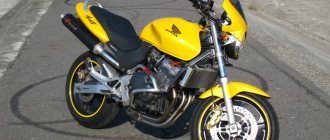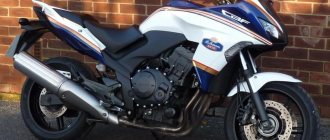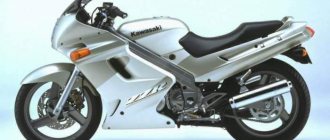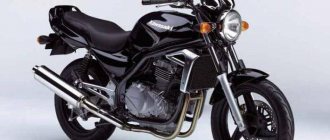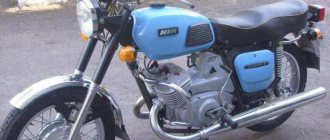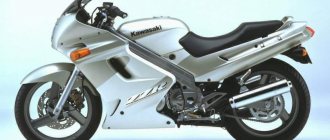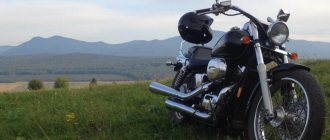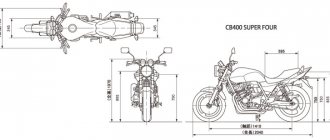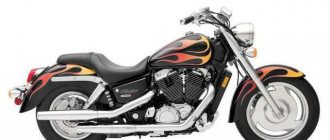Description
A motorcycle like the Honda NTV 650 has an excellent power unit, good handling, dynamic movement, and ergonomics in the exterior. As a rule, high-quality “iron horses” are distinguished by a rather high price.
The production of the model in question was suspended back in the late 90s of last year, therefore, now only used units can be purchased. Motorcycles with an engine capacity of over 400 cubic centimeters cannot a priori be classified as modifications for beginners. It is in this category that the Honda NTV 650 Deauville (647 cc) is classified. This two-wheeled vehicle is in many respects not inferior to and superior to most analogues. In general, the equipment under consideration can be briefly characterized as follows: a reliable, fast, beautiful and serious motorcycle.
Disadvantages of the model
- The V-twin engine is characterized by vibration at high speeds.
- On a dirt road it significantly loses controllability and power.
- Weak light.
According to owner reviews, the Honda ntv 650 revere is a very good option for daily driving due to its unpretentiousness and ease of maintenance . A comfortable fit allows you to adequately appreciate the bike even over long distances. Finding spare parts is not difficult, which is an exception for Japanese motorcycles.
Honda Revere is quite economical, so a full tank lasts for at least 250-300 km, and when driving on the highway, fuel consumption decreases. The motorcycle is designed to ride on good asphalt, so if you go onto a dirt road, you may encounter some problems.
Honda Bros 650 road bike model
produced from 1988 to 1992. Despite such a short release period, the model still has many fans around the world. At the time of its release, the Honda Bros 650 model was considered advanced in terms of technology - an aluminum diagonal frame, a Pro-Arm cantilever rear swingarm, installed on the Honda VFR750F sports tourer.
However, the main feature of the motorcycle is its engine, which is a V-shaped 2-cylinder liquid-cooled unit with a volume of 647 cc. see, producing 56 hp. power and almost 57 Nm of torque, available at 6000 rpm. The engine has smooth, confident traction at low and medium speeds. This engine was also installed on the Honda NT 650 Deauville and Honda XL 650 V Transalp models.
Main modifications of Honda Bros 650:
- Honda NT650 Hawk GT
- version for the American market. Produces 58.5 hp. power, has a 2-piston front caliper. Differs from other modifications in gearbox ratios. - Honda NTV 650 (Revere)
- version for the European market. Equipped with a steel frame, produces up to 60 hp. power, has a cardan drive, a 19-liter fuel tank, rebound-adjustable rear suspension and a center stand. Based on this modification, the Honda NT650V Deauville model was manufactured in 1998. - Honda NTV 600 (Revere)
- version for the English market. Identical to the previous one, but differs only in engine size and smaller carburetors. - Honda Bros 650
- version for the Japanese market. It has common features with the American modification, differing from it in colors, wheels, 4-piston front caliper, gearbox ratios, engine tuning (56 hp) and lower clip-on location.
The “younger brother” of the Honda Bros 650 is the Honda Bros 400.
Despite the generally interesting concept, the Honda Bros 650, NT650 Hawk GT and NTV600 models were completely discontinued in 1991-1992. The only exception was the European model Honda NTV650 Revere, which was on the market until 1998, after which it was replaced by the touring version Honda NT650V Deauville, built on the common NTV650 base.
Currently, only Japanese (Bros 650) and European (NTV650) versions are found on the Russian market, all others are extremely rare.
The main competitors of the Honda Bros 650 in the class:
Advantages and disadvantages
Judging by the reviews of owners and experts, the Honda NTV 650 bike has a number of objective advantages. These users include:
- Excellent build quality.
- Magnificent exterior.
- Speed reserve up to 300 km.
- Long wheelbase for increased stability at high speed.
- Excellent handling and adaptability for moving around the city.
- Easy to care for.
Among the disadvantages, the owners highlight the following points:
- At high speeds, vibration of the power unit is felt.
- On a dirt road, power and controllability are significantly reduced.
- Not very bright light elements.
- High price.
Review of the Honda Bros 650 motorcycle (NTV 650 Revere, NT650 Hawk GT)
It’s infinitely convenient to drive through traffic jams, because the motorcycle is narrow and the widest part is your hands on the clip-ons. (By the way, my clip-ons are low, and the landing is with a noticeable tilt forward. Would I say that it’s uncomfortable? I won’t say. On the P1, for example, the landing is really uncomfortable, but here everything is as it should be). The only negative is that the engine doesn’t really like extremely low speeds and at one point it can stall, tightly dragging the rear wheel with a skid - you have to play with the clutch. This did not cause any problems, but the situation was not the most pleasant.
Time passed - the realization came that the throw was not big at all, rather the opposite, and the engine began to growl pleasantly instead of thrashing wildly. Driving on the highway is quite comfortable if you drive at the speed of an office sedan: 80-90. If you drive faster, it starts to feel noticeably deflated and the ride becomes strained (or you have to lie down on the tank, which saves the situation, but also strains), and when you try to look back, your head automatically turns to the limit.
Even a small windbreak will pleasantly improve the situation. The fit is quite comfortable, even with my legs being a meter long (these are usually the case for people about 190 in height) there was no discomfort.
Overtaking cars is also easy. Two cylinders give a very cheerful kick in the ass, although with increasing speed you feel how the cheerfulness becomes less and less.
It is extremely difficult to change the battery with your bare hands (without tools): you took out the old one after about the 10th attempt, put the new one in so as not to crush the wires - about the same time. In addition, the expansion tank is located very inconveniently.
At high speeds, vibrations make themselves felt, but due to the universal gears (in third, for example, you can drive in a very wide range of speeds, and in heavy traffic around the city you don’t need to leave first at all) you can safely drive at 2-3 thousand and don't tense up. The box is truly Honda, everything is soft and clear. The first one must really be “stuck”, otherwise the gears click unpleasantly when turned on slowly.
The brakes are weak and not very informative: if you are not used to it, it will be difficult to slow down effectively. For a quiet ride, it’s quite enough. Oh yes, during this very braking, your groins will be unpleasantly pressed directly into the tank, so you have to constantly hold the fifth point. The tank, by the way, is quite small, with a consumption of 5-6-7 liters per hundred, you will suddenly (at first) run out of gasoline an unpleasant surprise.
For a quiet ride, it’s quite enough. Oh yes, during this very braking, your groins will be unpleasantly pressed directly into the tank, so you have to constantly hold the fifth point. The tank, by the way, is quite small, with a consumption of 5-6-7 liters per hundred, you will suddenly (at first) run out of gasoline an unpleasant surprise.
I don’t complain about the light, because the previous owner installed a bi-xenon lens - it shines perfectly. No matter how much I wanted a motorcycle for the track, the throw turned out to be very urban indeed. However, with certain modifications it is quite suitable for such trips. Should I buy bros? Definitely. A very charismatic motorcycle.
I owned this device for about a year. This was my first Japanese motorcycle. Before him there was a break from riding a motorcycle for about 5 years, and before that Owls, Izhi, etc.
The motorcycle is very unusual, which is why it captivates. V-twin, but not a chopper, no plastic, but a fit with clip-ons, like on a sport, a beautiful aluminum frame, a swingarm, a pleasant sound. The main disadvantage of this motorcycle is its age.
We drove about 5 thousand km with him, mostly around the city. In the city it has no equal, very nimble, maneuverable, with confident traction at low revs - I overcame any traffic jam effortlessly. It was quite sad on the track. Above 150 km/h. he really didn't like driving, the suspension was very soft (partly due to his age), the brakes were quite sluggish, and the wind really got in the way. It’s not comfortable for both of us to ride together, because of the suspension, brakes, and because it’s really small. With my height of 187 cm, I felt on it like on a bicycle, although the fit did not cause discomfort.
In general, the motorcycle leaves positive emotions and is a good option as a first motorcycle. The 650 cc version drives approximately with the dynamics of a sports 400, but gives more emotions due to the engine.
I skated on my season - I got a little 3600. Before that, under me there were only Soviet models of the motorcycle industry, such as Minsk, Voskhod. I traveled a little on Yavka. But a Japanese is a Japanese. There can be no comparisons here. Over the entire period of operation, Bros has never let me down. Started in any weather without problems. Doesn't consume oil, consumption is from 3.5 - 4.5 per hundred square meters. If you drive well (for 150) then 5.5 liters. In the city it is simply ideal - narrow, nimble with excellent acceleration dynamics from low revs. Lightweight, which is important for lightweight guys and girls. They can handle it without stress. For me, it’s generally like a bicycle) Pleasant vibration, at speeds above 4500 it feels like there’s a jackhammer under you, but it didn’t bother me. But what a sound this song is. Still, the V-twin is power and roar. Even the deaf can hear this sound in traffic jams, between cars) Gears shift without problems, neutral is caught well. The track is not good for him. After 130 - 140 it starts to blow away (you have to lie down on the tank, but this doesn’t help much and is inconvenient), the flow from the trucks also makes itself felt, potholes, pits and other irregularities are perceived very poorly by Bros. Therefore, it is better not to drive on a bad road above 90. Mostly I traveled alone. Sometimes there was a second number in the back, but... Throwing 650 didn’t really strain even with two (although the difference is certainly felt), but the main disadvantage is that it becomes very cramped (especially for the passenger) and it wasn’t very comfortable for me. Drive in this position for over 50 km. It’s very stressful and dreary; long-distance travel together is out of the question. There are legends about the reliability of Brosov - I confirm it. I got into such downpours with it that the cars flooded and they stalled, but I drove without any problems. Everyone remembers the summer of 2010 - it was + 30 and above, the city stood still, the cars were boiling. I'll give it a whirl))) There wasn't even a hint of heat in the engine) In general, for the radiator fan to work on it, when you're just standing in the heat, you have to wait 15 - 20 minutes, and this is with the engine warm, and at the same time rev it up a little , and if you move at least 40, then you won’t hear the sound of the fan at all))
But.. I want something bigger and bigger both in cubic capacity and in volume. So I decided to take a liter, sports class - tourist. It’s sad, but I’ll be parting with Brosik. I recommend it as a first motorcycle, for trips in the city, and for those who can’t go further than to the country (even with a passenger).
Honda NTV 650 Deauville
This modification of the touring motorcycle was produced from 1998 to 2006. Later it was replaced by an updated version of the NTV 700. The device can more often be found on the European or American market, since it is an export version.
Options:
- The engine is a V-shaped power unit with a pair of 647 cc cylinders. cm.
- Power – 56 horsepower.
- Torque moment – 57 Nm.
- The maximum speed is 170 km/h.
- Braking system - discs.
- Fuel tank - 19.5 l.
- Weight – 223 kg.
- Transmission – 5 speeds.
Owners note the quiet operation of the engine along with high efficiency.
Honda NT 650 Deauville
Brief review of Honda NT 650 V Deauville
Honda NT 650V Deauville is a lightweight touring motorcycle aimed mainly at the USA and Europe. It was not officially sold in Japan. This model is intended primarily for those who want to try the class of touring bikes, but do not want to immediately get on powerful and heavy models, or do not have the budget to purchase them.
The technical characteristics of the Honda NT 650 Deauville can be called quite modest (the same engine was installed on the touring enduro Honda Transalp 650, and its roots go back to the 80s), but this motorcycle also has undeniable advantages - a simple, but very reliable and durable design , smooth running and low price. In addition, it is quite possible to service this model on your own (if you want to save money), since this motorcycle is not anything complicated.
Throughout its production, the Honda NT 650 Deauville was modernized only once - in 2001, the motorcycle received improved brakes and slightly larger integrated panniers. The volume, however, still remained quite modest. However, the model was popular enough to be produced for a long time, after which it was replaced by a new 700 cc modification - the NT 700.
Similar motorcycles:
- Honda NT 700 Deauville
Technical characteristics of Honda NT 650 V Deauville
- Years of production: 1998-2006
- Class: tourist
- Frame: diagonal steel
- Engine: 4-stroke, 2-cylinder, V-shaped
- Engine capacity, cubic meters see: 647
- Cooling: liquid
- Valves per cylinder: 3
- Fuel supply: 2 carburetors
- Power: 56 hp (at 7900 rpm)
- Torque: 57 Nm (at 6000 rpm)
- Maximum speed, km/h: 180
- Acceleration from 0 to 100 km/h: ~5.5 seconds
- Transmission: 5-speed
- Wheel drive: cardan
- Front tire: 120/70-17
- Rear tire: 150/70-17
- Front brakes: 2 discs 276 mm, 2-piston calipers (since 2001 - combined)
- Rear brakes: 1 disc 276 mm, 1-piston caliper
- Front suspension: telescopic fork
- Rear suspension: Progressive monoshock with preload adjustment
- Gas tank volume, liters: 19.5
- Fuel consumption at 110 km/h, liters: ~5.5
- Dry weight, kg: 233
Pros and advantages of Honda NT 650 V Deauville
- Low price for a used motorcycle
- Easy Maintenance
- Large gas tank
- Long range
- Reliable and fail-safe design
- Good wind protection
- Good brakes
- Adjustable footrests
Pros and cons of the Honda NT 650 V Deauville
- Simple suspensions are poorly adapted to poor quality roads
- Lack of fuel level sensor
- Unreliable fuel pump
Honda NTV 650 Revere: technical specifications
The following are the technical parameters that the motorcycle in question has:
- The power unit is a 647 cc four-stroke petrol engine. cm.
- Power – 60 horsepower.
- Maximum speed – 165 km/h.
- The gearbox is a five-speed cardan unit.
- Fuel consumption – 5 liters per 100 km.
- Gas tank capacity – 19 liters.
- Weight – 185 kg.
- Brakes - disc.
- Suspension: telescopic forks at the front, damper at the rear.
The Honda NTV 650 Revere motorcycle is equipped with a two-cylinder V-engine, which is worthy competition for similar power units. A good set of traction characteristics is combined with infrequent gear changes, regardless of speed.
The machine has a liquid cooling system and OHC fuel injection. Disc brakes make it possible to stop equipment quickly and smoothly. The five-speed transmission is combined with a cardan drive.
Release Features
Honda Bros 650 – chain drive.
Honda NTV 650 Revere – cardan drive.
In 1997, the line closed, giving way to the tourist Honda Deauville 650 , which appeared a year later. But despite this, it will have many solutions and details used on the Bros 650.
When planning sales markets, the company's engineers acted outside the box. There were no special restrictions, but each continent received its own, slightly modified version.
In particular, for European markets a cardan , although models for Japan/America received a chain . It is impossible to find new models now, but on the secondary market, there are both Japanese and European variations. For $3,000 you can find a pretty decent version without mileage in the Russian Federation.
Test Drive
It’s worth noting right away that at low speeds the NTV 650 Honda is somewhat more difficult to control than its analogues. Quite a lot of weight combined with a narrow handlebar means that considerable force is required. The wobbling is especially noticeable when overcoming holes and potholes. However, after a short period of time, you quickly get used to such features.
The suspension unit showed pretty good performance, although the motorcycle shakes noticeably on large potholes. Telescopes cope well with small uneven surfaces on the asphalt. To properly adjust the rear shock absorber stiffness, use special knobs (no additional tools required).
The engine spins vigorously in all gears, actively gaining momentum. To optimize its operation, it is advisable to synchronize the carburetors. For driving around the city, third speed is quite enough; the sound of the power unit pleases with a special powerful “purr” without disruptions or wheezing.
Peculiarities
The riding position on the motorcycle is standard for this type of machine. You can note the wide tank and rear-set footpegs. The driver feels confident at any speed, without moving from the “seat” during maneuvers.
The saddle itself is thick, wide and low. It also works as an additional shock absorber, taking away some of the load on bumps. In fact, this is a full-fledged double seat with an easy step and direct passenger seating. If desired, you can adapt the trunk so that there is somewhere to lean against from behind.
Advantages and disadvantages
At the rear there is a sports monoshock absorber with preload and rebound adjustments. The short suspension travel makes a positive contribution to handling, but makes the motorcycle quite rigid.
- The excellent maneuverability and narrowness of the bike (the parts that protrude beyond the sides are your hands) allow you to get through traffic jams on a par with small-capacity bikes.
- Elastic gearbox , thanks to which there is no need to change gears.
- Well-designed cooling - if you want to check the operation of the fan, you will have to stand still for about 20 minutes, periodically applying gas; under normal conditions it will not turn on.
- A real amphibian - even in heavy rain, when the box trucks stall with a flooded engine, this motorcycle will go.
- A city bike is ideally tuned for cutting through traffic jams; it loses its advantages when going on the highway; riding at an average speed of traffic, not to mention ahead, is quite problematic.
- Low clip -ons are a rare thing for a road worker and imply a rather low landing.
- Slippery saddle - even with smooth braking, the rider slides forward; we’ll simply keep silent about the possible consequences of a sudden action.
- Good handling and weight distribution.
- There is no need to “turn” the engine, it runs well even at 2.5-3 kph, but it is not recommended to let it go lower - you can suddenly stall.
As those who managed to ride say, it’s easier to ride than a bicycle.
Comparative characteristics of Honda NTV 650
Below are the main differences between the bike in question and its European counterpart, the Hawk GT. The parameters of the last unit are given in parentheses:
- Frame type – steel (aluminum alloy).
- Fuel tank - large 19 liter tank (compact 10 liter tank plus reserve tank).
- The steering wheel is standard (with clip-ons).
- The seat is large, low, soft with a full-fledged passenger seat (the saddle is high, compact and hard).
- Luggage compartments – there are several places for storing tools and other “small things” (there are practically no luggage compartments).
- The tail part protrudes beyond the dimensions of the wheel (a shortened tail that weakly protects the motorcyclist’s back from dirt).
- Switching box - during operation, the unit creates a characteristic sound during switching (the unit operates almost silently).
- Drive – cardan (chain).
Reviews
As the owners note, the technical characteristics of the Honda NTV 650 are excellent for driving within the city. Users consider the motorcycle’s unpretentiousness in operation and maintenance to be a positive aspect. The comfortable fit allows you to cover long distances without any problems. Unlike most Japanese bikes, purchasing spare parts for this unit is not particularly difficult.
Honda is economical; one refueling is enough for about 300 kilometers, depending on the condition of the road and driving style. A two-wheeled vehicle in this category is designed to move on high-quality asphalt, so controllability and dynamics are lost on a dirt road. Consumer reviews further confirm this fact.
Modifications
Honda NT650 Hawk GT – aluminum diagonal frame.
Honda NTV 650 Revere – steel diagonal frame.
Depending on the sales market, the model received several modifications that differed both externally and technically:
- Honda Bros 650 - version for the Japanese market. Main, road worker. 56 horses, 4-piston brake calipers, chain. Closed in 1992.
- Honda NT650 Hawk GT is a model for the American mainland. To a large extent repeats the Japanese version. Same power/torque ratings. 2 brake calipers on the front axle, chain. The cardinal difference is the reconfigured gear ratios in the gearbox, as a result of which it has lost its elasticity, forcing the owner to swing his left leg. Closed in 1991 .
- Honda NTV 650 (Revere) - European version. Steel frame. There are 60 horses under the hood. Also a pair of brake calipers. There are 3 main differences. The main cardan drive. The fuel tank has been increased to 19 liters (the mileage at one refueling has increased to 450-500 km ). Dry and curb weight increased by 24 and 27 kg, respectively. The only version whose weight exceeds 200 kg . It was assembled from 1988 to 1994 and from 1995 to 1997 (the line was idle for a year).
- Honda NTV 600 (Revere) — assembly for Great Britain. It is based on the European version, with all its advantages. But a smaller engine capacity and smaller carburetors are used. Produced with 1988 to 1991.
Honda NTV 600 Revere - the version for the English market, was no different in appearance.
Of the entire series, only the Japanese modification received a specially designed, own color scheme.
and competitors
The model was not left without competitors:
- Suzuki offered its “legend” SV650;
- Yamaha introduced the SRX600 .
Kawasaki could not present a competitive model. However, later the situation developed rather strangely. He responded to almost all competitors' developments in this scope with the ER-6 road builder.
About competitors
Let's take a brief look at the parameters of the main competitors of the Honda NTV 650 motorcycle:
- VFR 750 from . The device is equipped with a 748 cc engine with a power of 105 horsepower. The bike accelerates to 232 km/h and is equipped with a six-speed transmission. The fuel tank holds 21 liters of gasoline, the consumption of which is 7-8 l/100 km.
- NSR-125. Despite its aggressive, sporty appearance, the motorcycle has very modest parameters. Engine capacity – 125 cubic meters. cm, top speed – 120 km/h, number of cycles – 2, gearbox – 6 modes, fuel consumption – 4.3 l/100 km.
- Translap 600. This bike is a typical enduro bike. The engine power is 55 “horses”, the volume is 583 cubic meters, fuel consumption is 5-6 l/100 km, the speed threshold is 174 km/h.
- "Husvarna Strada". The motorcycle is equipped with a 625 cubic centimeter engine with a power of 58 horsepower. The weight of the unit is 186 kg, the capacity of the gas tank is 12.3 liters.
- BMW C600 Sport. Engine volume – 647 “cubes”, power – 60 “horses”, weight – 249 kg. Fuel tank capacity – 16 liters.
Specifications
| Honda Bros 650 | Parameter |
| Year of release | 1988-1992 (main model) |
| Engine | 4-stroke 2-cylinder V-twin liquid cooled, 647 cm³, 56 hp, starting - ELECTRIC STARTER |
| Transmission | 5-speed manual transmission (chain or cardan), multi-disc in oil bath, cable drive, no problems with neutral |
| Acceleration up to 100 km/h | 4.1 sec |
| Comfortable cruiser | 90 km/h |
| Ground clearance (distance to bottom point) | 15.5 cm |
| Maximum speed | 185 km/h |
| Fuel consumption | no more than 5.5 l (if you fry with all your money) |
| Gas tank volume | 12 l |
| Power reserve | 300 km |
| Curb weight | 181 kg |
The most interesting detail of the model is, of course, the engine.
Engine – right side view.
Engine – left view.
The developers installed a 4-stroke 2-cylinder V-twin liquid-cooled engine. Although they did a good job on the settings, users notice that it doesn’t really like low revs , preferring easy playback with the throttle.
But in its defense, it can be noted that it was the Honda XL 650 V Transalp that received it. The Deauville, the successor to the motorcycle, has the same engine.
